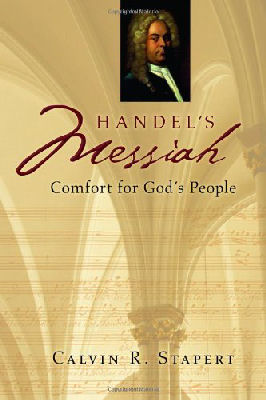
|
Posted December 7, 2010
Book: Handel’s Messiah: Comfort for God’s People Author: Calvin R. Stapert William B. Eerdman’s Publishing Co. Grand Rapids, MI. 2010. Pp. 173 An Excerpt from the Jacket:
Here you will find fascinating historical background to Messiah, including its unlikely inception, and learn about its reception and impact from Handel’s day to our own. Calvin Stapert devotes most of his book to scene-by-scene musical and theological commentary on the entire score, demonstrating how the music of the Messiah beautifully intertwines with and illuminates its biblical text. Through these pages Handel’s popular and much-loved masterpiece will be greatly enhanced for listeners old and new alike. An Excerpt from the Book: Scene 4 Chorus: Worthy is the Lamb that was slain, and hath redeemed us to God by His blood, to receive power, and riches, and wisdom, and strength and honor, and glory and blessing. Blessing and honor, glory and pow’r be unto Him that sitteth upon the throne and unto the Lamb for ever and ever. Amen. The final scene takes us to the throne room in heaven. To understand the full meaning of this chorus (actually a triptych of choruses) we need to know the context of the words. In Revelation 4 John sees twenty-four elders seated on thrones surrounding the throne of God, at the sides of which stand four living creatures — a lion, an ox, a man, and an eagle. They sing; “Holy, holy, holy, Lord God Almighty, which was, and is, and is to come.” Their hymn is augmented by the twenty-four elders who “fall down before him that sat on the throne. . .and cast their crowns before the throne, saying, Thou art worthy, O Lord, to receive glory and honor and power: for thou hast created all things, and by thy pleasure they are and were created.” God holds a scroll in his right hand, a symbol of authority. The scroll, as Matthew Henry explains, contains “the whole Mystery of God’s Counsel and Conduct” ---- words that recall Jennens’s motto for Messiah. But “no one in heaven or on earth or under the earth was able to open the scroll or to look into it.” So john weeps, but he is comforted when one of the elders says, “Weep not: behold the Lion of the Tribe of Judah, the Root of David, hath prevailed to open the book, and to loose its seven seals.” . . .The Lamb takes the scroll, and the four living creatures and the twenty-four elders fall down before the Lamb and sing a new song: Worthy art thou to take the book, and to open the seals thereof: for thou wast slain, and hast redeemed us to God by thy blood out of every kindred, and tongue, and people, and nation; and hast made us unto our God kings and priests; and we shall reign on the earth.” But this is not yet the climax. “Ten thousand times ten thousand and thousands of thousands” of angels join the four living creatures and elders, singing: “Worthy is the Lamb that was slain, to receive power, and riches, and wisdom, and strength, and honor, and glory, and blessing. The crescendo continues as “every creature which is in heaven, and on earth, and under the earth, and such as are in the sea, and all that are in them” continues the song: “Blessing, and honor, and glory, and power, be unto him that sitteth upon the throne, and unto the Lamb forever and ever.” And the living creatures say, “Amen!” and the elders fall down and worship. To say that it is a tall order to compose the music for this final chorus of Messiah would be a gross understatement. Suffice it to say that few could have succeeded as well as Handel did. He made of it a choral triptych like the one he made for the suffering of the Lamb in Part II. Both triptychs begin with a pair of choruses that could be call a prelude and fugue. (Here “Worthy is the Lamb” is the prelude, “Blessing and honor, glory and pow’r” is the fugue.) The third parts of the triptychs, however, are very different from each other — “All we like sheep” is light and airy like the secular duet from which it was derived; “Amen” is a highly sophisticated fugue. But each flows smoothly from its predecessors, both textually and musically. Table of Contents: Three Histories: “God moves in a mysterious way” 1. Oratorio before Handel 2. Handel 3. Messiah Purpose: “I wish to make them better” 4. To teach and delight 5. Messiah verus Deism Commentary: “Great is the mystery of Godliness” 6. Before we begin 7. Part the First: the coming of the Messiah 8. Part the Second: Lamb of God, King of Kings 9. Part the Third: Resurrection of the dead, worship of the Lamb |
|
